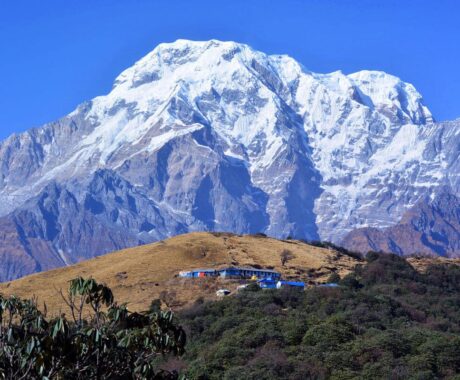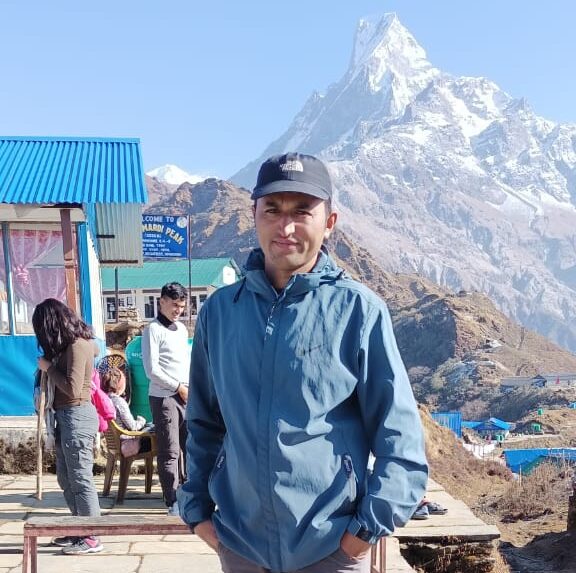Makalu Base Camp Trek
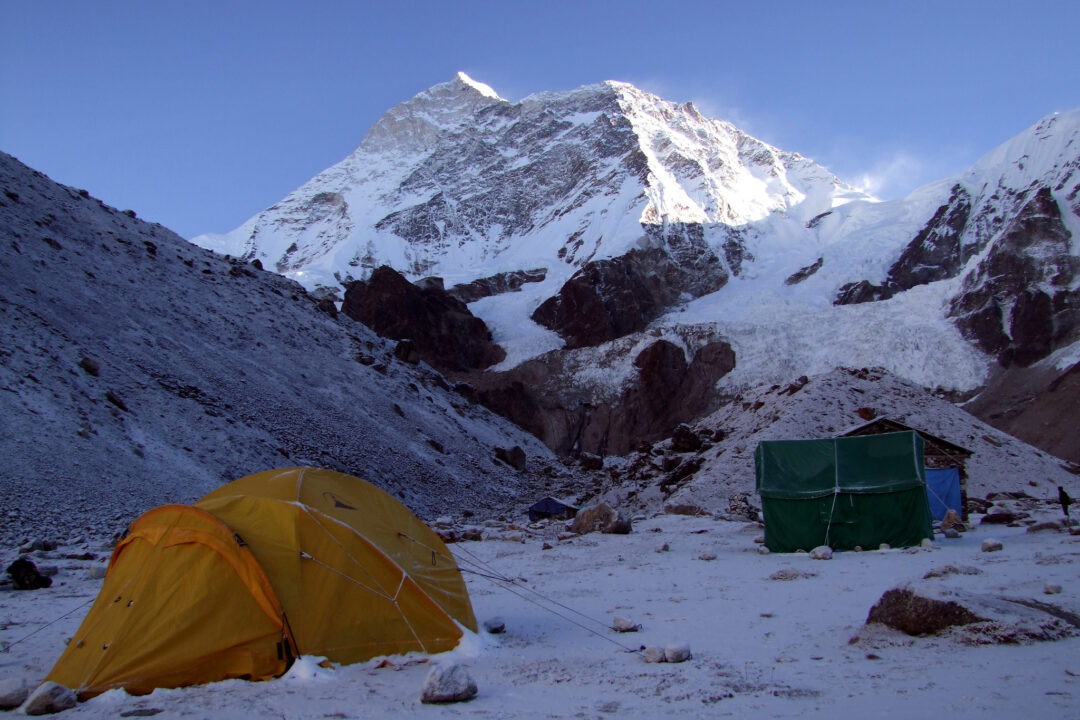
Trip Facts
- Destination Makalu Region Nepal
- Activity Trekking
- Duration 16 Days
- Trip Difficulty moderate
- Max. Altitude 5300
- Best Time September to December & March to june
- Start and End Kathmandu - Kathmandu
- Meals Breakfast / Lunch / Dinner
- Accommodation 5 star hotel in Kathmandu &Tea house
- Group Size 2 - 10
Trip Highlights
- Adventure around exotic Barun Valley enclosed by towering snow peaks
- On least ventured region of Far Eastern Himalayas to Makalu base camp
- Beautiful forest lined with tall rhododendron, pines, oaks and fir trees
- Trek from cooler mid-hills towards arctic zone of snow, ice and glaciers
- Explore the remote isolated villages adorned with traditional heritage cultures
Introduction
Mt. Makalu Base Camp Trekking is an adventure with RP Adventures that takes you around remote pockets of the Eastern Himalayas. The walk leads you to a stunning country towards high-altitude scenic destinations to the base of Mt. Makalu. Listed as the world’s 5th tallest peak from the 14th highest mountains on this planet earth.
A black pyramid summit towers high at 8, 485 m / 27, 838 feet, above the picturesque Barun Valley. Situated, at a distance of 19 km / 12 miles east of Mt. Everest and Mt. Lhotse. Due to its remote location, few groups of trekkers and mountaineers seldom venture to Makalu base camp and Barun Valley.But in the last few decades, the flow of trekkers is gradually on the rise.
As the facilities of lodge accommodation are built around Khongma and Barun Valley as far as Makalu base camp. Making it much better and easier than in earlier days when camping equipment was needed to carry throughout the trek.Mt. Makalu Base Camp although a high altitude adventure, where trekkers can get acclimatized on daily walks. As well as spending overnights at certain heights making the trek more exciting and enjoyable.
Mt. Makalu Base Camp Trekking begins with a sweeping scenic flight to land at the warm low farm town of Tumlingtar.Located in the district of Sankasabha of Nepal Eastern Koshi Zone, from this nice town. Taking a four-wheel drive towards cooler hills past the large town of Khandbari, headquarters of the district. As drive ends on a hill village at Num, where the air gets much cooler to start our adventurous walks.
Heading down and ups through smaller hamlets and farm villages to Seduwa, reaching Tashi-Gaon.The last permanent village en route to Makalu Base Camp and Barun Valley, leaving the last human settlement. A steep climb reaches you on the top of Khongma-La high ridge, after a good uphill climb through lovely dense forest.
From Khongma-La glorious views of Mt. Makalu, Barun Himal, and Chamlang Peaks with Mt. Kanchenjunga towards the east direction.The trail follows crossing smaller passes of Shipton-La, Keke-La, and Tutu-La reaching a glacial pond of Thulo and Sano Pokhari. Slowly the walk heads downhill back into tall tree lines to Mumbuk and then enter the scenic Barun Valley.The trail follows through smaller temporary settlements of Yangla Kharka and Yak herder summer grazing camps.
After Mumbuk the tree line gives away to short rhododendron and juniper bushes then reaches the main highlight. At Mt. Makalu Base Camp on the highest spot of the adventure encircled by towering snow peaks. The base camp is a lonely hut severing as Tea- House or lodge facing tremendous mountain views.Enjoy the alluring scenery of Mt. Makalu with famous, rare views of Khansung East Face of Mt. Everest towards the North-West.
After an exciting and amazing experience within remorseless fields of ice and glaciers and giant peaks. Return journey on the same scenic route with a climb towards Mumbuk and Dobato to reach Khongma Ridge. Then finally the walk heads downhill to Tashi- Gaon and Seduwa to end the walk at Num village.An interesting drive on mountain rough tracks brings you low warm farm country at Tumlingtar for the last overnight halt.
The next morning a short scenic flight reaches Kathmandu, after a great wonderful adventure on Mt. Makalu Base Camp Trekking.Mt Makalu, the fifth-highest peak in the world, standing majestically at 8453m (27,760ft). Nestled between the formidable Mt. Everest and Mt. Kanchenjunga, Makalu resides in the Mahalangur Himal range, straddling both Nepal and Tibet.Known as the “Black Mountain,” Makalu holds a sacred significance in Hinduism, beckoning adventurers and spiritual seekers alike.
It was first conquered by the indomitable duo J. Cousy and L. Terrey, leading a French expedition team. Today, Makalu offers five distinct climbing routes, each presenting its own unique challenges and variations, all leading to the awe-inspiring summit. The irresistible allure of Makalu tempts hardened adventurers from across the globe to conquer this majestic “Black One.”
Just 5km northeast of Makalu, in the Mahalangur or Khumbu Himalayas of Tibet, stands Chomolonzo. This stunning mountain, often spelled as Chomolonze, Jemolonzl, or Lhamalangcho, boasts three distinct summits, offering climbers an added dimension of exploration. Come experience the exhilaration of conquering these towering Himalayan marvels and etch an unforgettable chapter in your adventure story.
Best Seasons for Makalu Base Camp Trekking
- The best seasons for Makalu Base Camp treks are spring and autumn. The spring season begins from (March to May) when most days are full of sunshine. The right time for wildflowers is in seasonal bloom, especially the rhododendron of various species and colors. Afternoon can get overcast with few showers and snowfall sometimes with cold mornings and nights altitudes wise
- The next best season is autumn/fall starting from (September to November) most days are fine and crystal clear. For views and pleasant walks, but cold morning, late afternoon, and nighttime. Can expect snowfall above 3,000 m sometimes
What to expect on Makalu Base Camp Trekking?
- Journey from low warm sub-tropical climate to cooler hills and ending at cold arctic zone at Makalu Base Camp
- Lovely farm villages of mixed ethnic hill tribesn of Kirat Rai, Gurung, Tamang and Newar. A blend of Hindu and Buddhism cultures, further up populated by the Sherpa. The Highlanders of Eastern Himalayas follow Buddhism religion and cultures similar to their Tibetan predecessors
- Walking uphill amidst dense lovely rhododendron and pine forest, reaching a wide open ridge of Khoma Danda. Facing splendid views of Makalu and Kanchenjunga Himalayan range
- Exploring the scenic Barun Valley enriched with rare flora and fauna, overnights in a simple mountain lodge. Enjoying grand views of giant peaks includes rare and famous the ‘Khansung East Face of Mt. Everest’. Sweeping panoramic flight both ways facing the worlds four highest peaks Mt. Everest, Lhotse and Makalu with Mt. Kanchenjunga
Outline Itinerary
Day 01: Arrival in Kathmandu and transfer to Hotel – 1,400m.
Day 02: Free day in Kathmandu – Exploration and Preparation.
Day 03: Fly to Tumlingtar – 1,700m and Drive to Seduwa -1,500m.
Day 04: Seduwa to Tashigaon Trek – 2,050m.
Day 05: Trek from Tashigaon to Kauma -3,470m.
Day 06: Kauma to Mumbuk trek – 3,500m.
Day 07: Mumbuk to Nehe Kharka Trek – 3,600m.
Day 08: Trek from Nehe Kharka to Shershon – 4,720m.
Day 09: Shershon to Makalu Base Camp trek – 4,853m.
Day 10: Full Day at Makalu Base Camp.
Day 11: Trek from Makalu Base Camp to Shipton-La Camp – 4,261m.
Day 12: Trek from Shipton-La Camp to Seduwa – 1,700m.
Day 13: Trek from Seduwa to Mure 1,980m.
Day 14: Trek from Mure to Tumlingtar – 1,700m.
Day 15: Fly from Tumlingtar to Kathmandu – 1,400m.
Day 16: Departure
Alternative Treks Around Makalu Base Camp Trek
The Makalu Base Camp Trek is a remote and challenging trek to the base of Mount Makalu (8,485m), the world’s fifth-highest peak. This trek offers untouched wilderness, diverse landscapes, and fewer crowds compared to other popular trekking routes. If you’re looking for alternative treks in the Makalu and eastern Nepal region, here are some great options:
- Makalu Base Camp Helicopter Tour – 1 Days: A shorter way to experience the beauty of Makalu Base Camp from the sky, offering stunning views without the long trek.
- Kanchenjunga North Base Camp And Lumba Sumba – 29 Days: A remote adventure taking you to the base of Mount Kanchenjunga, with diverse landscapes and cultural immersion, perfect for those seeking a peaceful yet adventurous trek.
Detailed Itinerary
-
Day 1: Arrival in Kathmandu and transfer to Hotel.
Upon arrival at Tribhuvan International Airport, you’ll be greeted with a warm Nepali welcome. After handling immigration and obtaining your visa, transfer to your hotel in the lively district of Thamel or another area of your choice. Use the day to relax and explore a bit of Kathmandu’s lively atmosphere, with vibrant colors, friendly locals, and enticing aromas of traditional cuisine. You are surrounded by the cultural essence of a city, and this first glimpse of Nepal paces up the days ahead.
Altitude: 1400mMeals: BreakfastAccommodation: 5 star hotel in Kathmandu -
Day 2: Free day in Kathmandu - Exploration and Preparation
Spend a day visiting the UNESCO World Heritage Sites of Kathmandu, including Pashupatinath Temple, Swayambhunath—also known as Monkey Temple—and Boudhanath Stupa. These sites reflect the deep spiritual roots of Nepal, with each having a different story to tell. Stroll through the busy streets of Thamel to get trekking gear, try some street foods, or visit the historic Patan Durbar Square. Rest and gear up for the official start of the trek tomorrow.
Meals: BreakfastAccommodation: 5 star hotel in Kathmandu -
Day 3: Fly to Tumlingtar- 1,700 m, and Drive to Seduwa- 1,500 m
Your trekking adventure starts with the early morning flight from Kathmandu to Tumlingtar. The 50-minute flight is scenic as you see the Himalayan range while descending into Tumlingtar. From here, you drive for about 4 to 5 hours in a local jeep to reach Seduwa, seeing the glimpses of rural life. You will pass through the terraced fields and traditional villages, and at times, you are surrounded by the subtropical forests. Overnight in Seduwa.
Altitude: 1,500 mMeals: Breakfast / Lunch / DinnerAccommodation: Tea house -
Day 4: Seduwa to Tashigaon Trek
Start your trek in earnest, heading towards Tashigaon through picturesque landscapes filled with rice paddies, thick forests, and glimpses of the Makalu region’s distinctive wildlife. Passing through small villages, you’ll see locals tending to their fields and experience the warmth of the Rai and Sherpa people. Tashigaon is the last permanent settlement on the trek, making it a great spot to enjoy local hospitality.
Altitude: 2,063 mMeals: Breakfast / Lunch / DinnerAccommodation: Tea house -
Day 5: Trek from Tashigaon to Kauma
Today is a tough day, as the trail will go steeply up through the dense forests of rhododendron and bamboo. The trek to Kauma requires endurance but rewards you with awe-inspiring views as you go up towards the mountains. Kauma is a high ridge with expansive views, which make the climb worthwhile, especially at sunrise and sunset.
Altitude: 3,470 mMeals: Breakfast / Lunch / DinnerAccommodation: Tea house -
Day 6: Kauma to Mumbuk trek
Walk into the Barun Valley today, one of the most unspoiled and isolated places around, which the locals consider a sacred place. Moving through rocky landscapes and alpine forests, you come across many types of flora and fauna indigenous to this area. Surrounded by lush forests, Mumbuk is a peaceful place providing the perfect location to end this day.
Altitude: 3,500 mMeals: Breakfast / Lunch / DinnerAccommodation: Tea house -
Day 7: Mumbuk to Nehe Kharka Trek
The trail today crosses rivers and meadows in a winding path. Nehe Kharka is the peaceful retreat of the Barun Valley. Strolling through the greenery and serene atmosphere, one will come across alpine flowers, trickling streams, and an unspoiled natural setting that makes Nehe Kharka a trekkers' paradise.
Altitude: 3,660 mMeals: Breakfast / Lunch / DinnerAccommodation: Tea house -
Day 8: Trek from Nehe Kharka to Shershon
As you ascend further up the Barun Valley, you will observe topography changing to more resistant, alpine terrain. You will pass beneath gigantic rock faces and through small villages until you reach Sherson, just below the Lower Barun Glacier. From here, take a moment to observe the stunning scenery of the peaks around you as the air becomes crystalline and clear.
Altitude: 4,720 mMeals: Breakfast / Lunch / DinnerAccommodation: Tea house -
Day 9: Shershon to Makalu Base Camp trek
Today's trek is shorter and takes you to Makalu Base Camp. Surrounded by Makalu, Everest, and other peaks, the views are spectacular. At 4,870 meters, take a minute to soak in the otherworldly landscape before you: dramatic glacial features and rugged mountain vistas in every direction. Later, descend back down to Nehe Kharka for a well-deserved rest.
Altitude: 4,853 mMeals: Breakfast / Lunch / DinnerAccommodation: Tea house -
Day 10: Full Day at Makalu Base Camp
Today, you have the whole day at leisure at Makalu Base Camp: taking pictures and observing the glacier, looking at the huge mountains that surround you. If lucky, a Himalayan snow leopard or even rare blue sheep grazing not very far away could be seen. Enjoy the peace and quiet while taking in the grandeur of the Himalayas.
Altitude:Meals: Breakfast / Lunch / DinnerAccommodation: Tea house -
Day 11: Trek from Makalu Base Camp to Shipton-La Camp
Begin your descent to Shipton-La Camp. You will pass through very well-known but equally magnificent scenery, gaining panoramic views as you approach your camp. This campsite offers a unique vantage point for the sunset over the mountains.
Altitude: 4,216 mMeals: Breakfast / Lunch / DinnerAccommodation: Tea house -
Day 12: Trek from Shipton-La Camp to Seduwa
Today's hike is all the way downhill through thick rhododendron forests and rocky trails. You will be enchanted with the distant view of Kanchenjunga on the way. Tiring, yet dropping down exhilaratingly to Seduwa.
Altitude: 1,700 mMeals: Breakfast / Lunch / DinnerAccommodation: Tea house -
Day 13: Trek from Seduwa to Mure
Trek down today to the village of Mure, which lies within the lovely Num Valley. Pass through fields and small settlements, coming to appreciate the simple life here in this remote area. Overnight at a teahouse in Mure.
Altitude: 1,980 mMeals: Breakfast / Lunch / DinnerAccommodation: Tea house -
Day 14: Trek from Mure to Tumlingtar
This last leg takes you back to Tumlingtar, where you first began. Just sit back, relax, and enjoy the last glimpses of the rugged beauty of the Makalu region as you travel in a jeep. Take in the final sights of the landscapes you have grown so accustomed to over the past days.
Altitude: 1,700 mMeals: Breakfast / Lunch / DinnerAccommodation: Tea house -
Day 15: Fly from Tumlingtar to Kathmandu
A morning flight takes you back to Kathmandu, signaling the end of your adventure. Spend your day at leisure upon return: have dinner to celebrate your feats, visit a traditional spa to relax, or just roam around the lively city with new eyes.
Altitude: 1,400 mMeals: Breakfast / Lunch / DinnerAccommodation: 5 star hotel in Kathmandu -
Day 16: Departure
Meals: Breakfast
What's included
- International and Domestics Airport pick up and drop
- 5 Star hotel in Kathmandu 3 Night (Bed and Breakfast incoludined )
- An Experience English speaking guide and porter (1 porter for every 2 trekkers)
- Kathmandu City Sightseeing by Private vehicle
- Trekking permits,TIMS and Makalu National park permits
- All Meals and Teahouse accommodation during the trek with attach deluxe room
- Kathmandu Valley Sightseeing with private jeep and tour guide (Local Monuments entrance fee included)
- Kathmandu to Tumlingtar and same way flight ticket
- Tumlingtar to Num and same ways back Jeep
- Seta light phone
- Medical kits
- Guide, porter insurance with food and Accommodation
- Basic Medical kits
- Sleeping and duffel bag, down jacket, trekking poles (should be returned after the trek)
- Farewell dinner
- Emergency Helicopter Evacuation Service Arrangement Only (should cover by your travel insurance)
- All required paper works and government taxes
- RP Adventures T-shirt
What's not included
- International Flight
- Nepal Travel Visa Fee
- Personal Medical and Travel insurance (Should cover helicopter evacuation)
- Guide, Porter and Driver tips
- Personal Gears (equipment)
- Personal bill
- Lunch and Dinner in Kathmandu
- All other personal expense of beverages (hard and soft drinks)
- All other things not mentioned in the inclusion
Trekking Gears
The Makalu Trek Region, located in eastern Nepal, offers an unparalleled adventure for trekkers. Dominated by Mount Makalu, the fifth highest peak in the world, this remote region boasts pristine landscapes, dense forests, and high-altitude terrains. Trekkers can experience diverse flora and fauna, including rare species like the red panda. The cultural richness of local Sherpa communities adds to the allure, making the Makalu Trek a must-visit for those seeking both natural beauty and cultural immersion.
To ensure a safe and comfortable trek in the Himalayan region, it is highly recommended to bring the appropriate equipment and gear to cope with the cold temperatures. The following is a list of essential equipment and gear for Makalu Base Camp Trek, which can be purchased either in the Thamel market or brought from your home country.
The following basic checklist for trekking and hiking equipment should assist you in packing for our trips. Keep in mind the importance of minimizing the weight of your clothing and gear. Your packed trek bag should weigh less than 15 kilograms. Remember, this is merely a guideline and not everything listed is essential to bring.
- Lightweight thermal gloves
- Hiking boots
- 2 pairs of thin and 2 pair of thick woolen socks.
- Trekking trousers
- Waterproof (trousers / jacket)
- Base layer shirts
- Underwear (4)
- Sun hat or scarf
- Thin, lightweight (inner socks) (4)
- Head lamp ,spare bulbs, & batteries
- Small padlock to lock trek bag
- Plastic bags - for keeping items dry inside trek bag
- Small wash towel
- Basic First Aid Kit
- Sun protection (including total bloc for lips)
- Trekking poles
- Down jacket
- Water bottle 1 liters
- Hand wash
- Snow glasses and sunglasses
- Duffle bag or kit bag to carry to gear while trekking.
Additional Equipment Checklist
- Headband or Beanie
- Swiss army knife
- Lip guard
- Sun lotion
- Scarf or neck Band
- Rain jacket/ Umbrella
Map
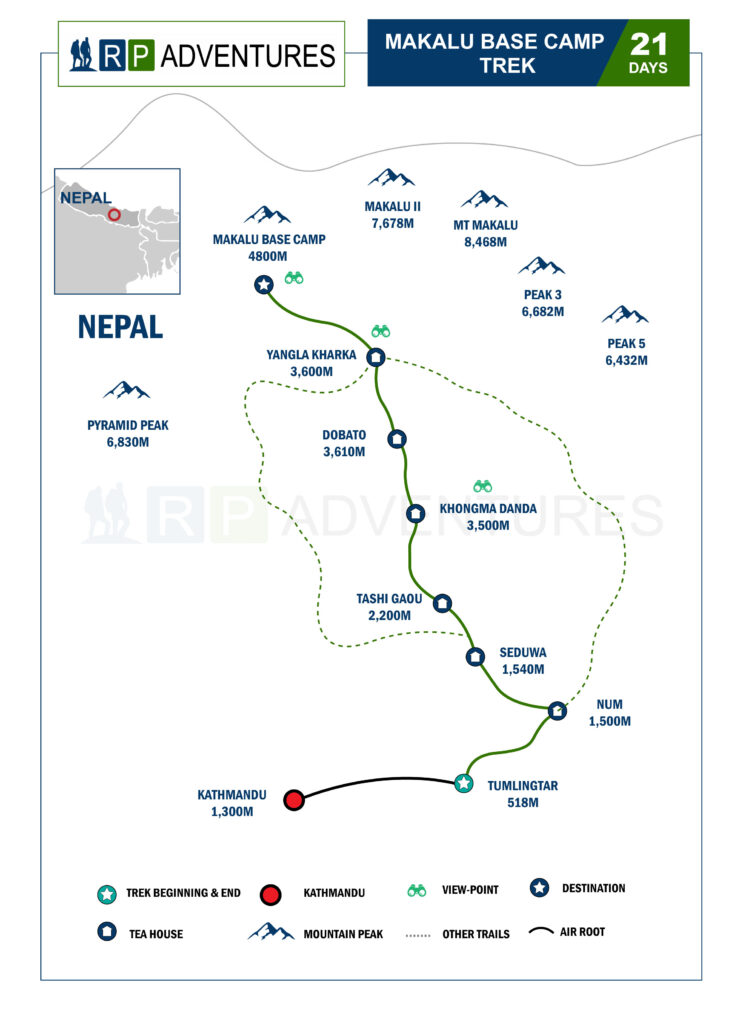
FAQs of Makalu Base Camp Trek
-
How hard is Makalu base camp trekking?
One of the best moderate and adventurous trek of all 8,000 m peaks base camps. Makalu base camp a little more than two week durations, on this trek without much problem of altitude sickness; or AMS (Acute Mountain Sickness). The walk leads with gradual rise in altitude each day reaching the height at 4, 870 m / 15, 978 feet. The daily walk helps and supports acclimatization as well spending overnights at certain heights en route Makalu Base Camp.The only tough part of the trek is climbing uphill to Khongma Danda, Ridge and long downhill walks on return treks. During adverse weather conditions, it is not possible to traverse Kauma La Pass (4,000m), Tatula/Shipton Pass (4,125m), Kalo Pokhari (4950m), and Kiki La Pass (4,170m). However, with the assistance of local residents, we collaborate to clear the way and facilitate passage during such challenging situations. -
How are the foods and lodge on trekking?
All meals are served with care and hygiene in every lodge en route trekking, where our guides all makes sure that the meal is all right for you, meals served as per the menu provided by the lodge. Main meals Nepali Dal / Bhat (boiled rice-mild vegetable curry with Dal and pickles of your choice) vegetable serves depends upon season, meals include fried / boiled noodles with eggs / veg or plain of your choices. Continental dishes also available in most of the lodges on treks. Most lodges till Tumlingtar is simple rooms with common toilets and bathrooms. Where one has to pay extra for hot showers as well for charging electronic items. -
Are there any health care or hospital on route trekking?
The only hospital is in Khandbari, the major town and headquarters of the district around Makalu region. Rest of the villages have small health post but lacks experienced doctors or medical staff. On trek, our guide will carry comprehensive medical box with medications for general illness and wounds only. -
How about safe drinking water?
At every lodge that you stay overnights, our guide and lodge owner will refill your water bottles with hot boiled (or cooled) water, which is safe for drinking purpose. Buying bottled water can be quite expensive on mountains area it will be a hazard with waste empty water bottles. As every trekking company are committed to Eco and Responsible Tourism, our guide discourages buying plastic water bottles, only in emergency situations.Purifying tablets does work only 30-40 % in Himalayan waters (due to heavy minerals contain like magnesium-iron and bi-carbonates), the only safe is way boiled cooled water. -
Does all cell / mobile phones works on trekking?
Depending upon the areas if you are in deep gorge and valley chances of communication on cell / mobile phone is less, but in high ridge and hills most of the mobile do receives signals. Most local areas where cell-phone works mostly in towns and villages, most lodge and shops / stores on trekking have STD / ISTD phones which can cost much higher due to its remoteness. But in deep gorges and hidden valleys the internet services get slow and disturbed sometimes. -
How many days we take to do Makalu Base Camp trek?
Normally, the Makalu Base Camp trek takes 18 to 20 days, but nowadays, with trekkers being mentally and physically fit, they can complete it in 12 to 16 days. -
How much cost for the Makalu Base Camp Trek?
Typically, the cost of the Makalu Base Camp Trek depends on your budget, ranging from $1500 to $4000. -
Can Solo trekkers do this trek?
Yes, solo trekkers can undertake this trek. However, we highly recommend hiring a porter and guide. -
Where does Makalu Base Camp located?
Makalu Base Camp is located to the east of Mount Everest, to the west of Kanchanjunga, and in the northern part of Sankhuwasawa. -
How high is Makalu Peak?
Makalu have 8485m altitude from the sea level, stand as a fifth highest mountain in the world. -
Which is the best view point for Makalu Base Camp trek?
Kongma La is the best viewpoint in this area, offering stunning views of mountains such as Mt. Makalu, Mt. Kanchenjunga, Mt. Lhotse, and Mt. Everest. -
How far is it from Makalu Base camp to Swiss Base Camp?
Normally, people complete the journey from Makalu Base Camp to Swiss Base Camp in one day. -
How difficulty is Sherpini Col and how high it is?
Sherpini Col is one of the highest and most challenging passes in Nepal, located between Makalu overpass and Chukkung Valley. -
What are the documents required in this trek?
A copy of passport, pp size photo, Makalu National Park permit and TIMS card are the required documents for this trek. -
How much tips we should give to guide and porter?
Depending on the total package cost, 10% is allocated for the guide, and 5% is designated for the porter. -
During the trekking is western toilet available?
Normally, in this region, the tea houses that are beginning to develop only have Indian-style toilets. -
How we know the experienced guide and porter?
Our organization primarily focuses on organizing high-quality services and employing experienced guides. The members of our guide team have been working for over 10 to 15 years. -
What kind of animal are found in this region?
The animals that can be seen in this region include cows, oxen, goats, yaks, nyaks, monkeys, blue sheep, and others. -
Is this trek a remote?
Yes, it is a very remote trek. After Tashi Gaun, we don't encounter any original villages, people only operate teahouses during the season. The entire area comprises jungles, landscapes, and glaciers. -
Which is the best time to do this trek?
Normally, we highly recommend trekking during autumn and spring, such as in the months of September, October, November, March, April, and May. -
Do we cross river and lake during the trek?
Yes, we cross the famous rivers Arun, Thul Taal, and Kal Taal, respectively. -
What are the possibilities for emergency case?
In emergency cases, typically, primary treatment is administered first. Subsequently, an assessment of the condition is made, and depending on the severity, the individual may be transported via helicopter rescue or carried to a hospital in Khandbari or Kathmandu. -
Is this a popular and famous trek?
Yes, it is famous, but fewer trekkers visit this area. -
During the trek are there any difficulty passes?
Yes, during the trek from Kumodanda to Dobato, they have to cross three passes in the same day. -
Is Shiva dhara trek, in this area?
Yes, it is there, and it is mostly famous in Hinduism and Buddhism. -
How high is Shiva cave?
Shiva Cave is situated at an elevation of 4,000 meters above sea level. -
How is the trail condition for this trek?
The trail conditions follow the typical trekking route, consistently navigating through jungles, ascending and descending hills, and crossing rivers.
Trip You May Like
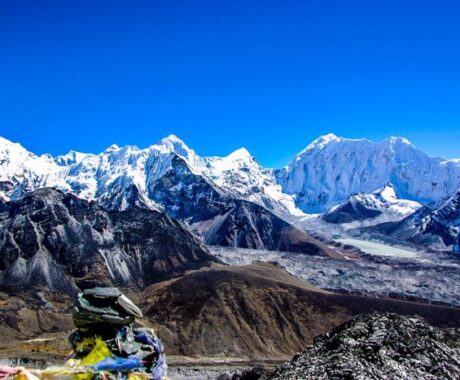
Rolwaling – Tashi Lapcha Pass
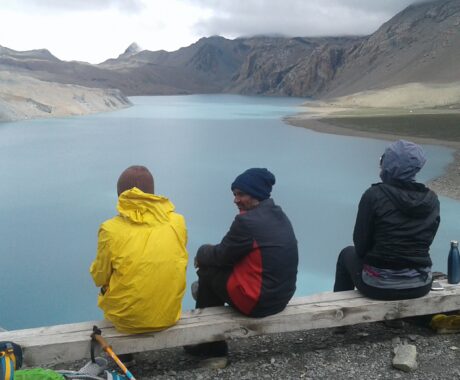
Annapurna Three High Passes trek
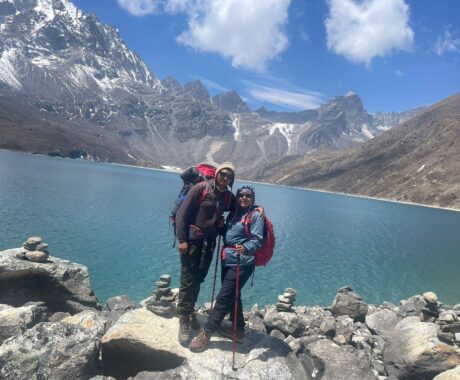
Gokyo Lake Trek
